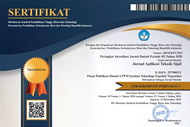Evaluasi Kinerja Operasional MRT Jakarta Menggunakan Big Data Pasca Covid-19
Abstract
The performance of public transportation is a very important main indicator because it can represent the success of the implementation of public transportation. This study aims to determine the operational performance of the MRT Jakarta public transportation after Covid-19 based on passenger tapping data (big data) and user perceptions. This big data will be processed into an Origin - Destination matrix, to get the Load factor and Utilization Factor values. In this study, in assessing whether or not public transportation performance is good, we will use secondary survey data on public transportation performance standards from journals in providing MRT and LRT services in the cities of Singapore, Hong Kong, and the United States, which of course refers to the Decree of the Director General of Land Transportation in Indonesia (SK/687/AJ/DRJD/2002). The results of the study show that the operational performance of the Jakarta MRT is currently good from several factors based on users perception and standard used. The results of the analysis show that the MRT Jakarta average occupancy rate or load factor value is 67% and utilization factor value is 0,66, which means that the performance of MRT Jakarta from the ridership side is still not optimal.
Keywords
Full Text:
PDFReferences
V. D. Putri, K. Komarudin, and A. R. Destyanto, “The determination of MRT (mass rapid transit) Jakarta train specification to reach headway target by using promodel,” Proc. - 3rd Int. Conf. Comput. Intell. Appl. ICCIA 2018, no. 978, pp. 16–20, 2018, doi: 10.1109/ICCIA.2018.00011.
Y. Wang, Y. Liang, C. Li, and X. Zhang, “Operation Performance Evaluation of Urban Rail Transit PPP Projects: Based on Best Worst Method and Large-Scale Group Evaluation Technology,” Adv. Civ. Eng., vol. 2021, 2021, doi: 10.1155/2021/4318869.
UU 22 Tahun 2009, “UU 22 Tahun 2009,” 2009, [Online]. Available: dpr.go.id
Q. K. St, H. K. Dist, and H. Hiroshima, “Income-based Fare Orientation in Urban Public Transportation Services in Developing Countries : A case study in Hanoi , Vietnam,” J. East. Asia Soc. Transp. Stud., vol. 13, no. 2015, pp. 1300–1311, 2019.
A. Venkatesh and S. Kushwaha, “Short and long-run cost efficiency in Indian public bus companies using Data Envelopment Analysis,” Socioecon. Plann. Sci., vol. 61, pp. 29–36, Mar. 2018, doi: 10.1016/j.seps.2017.04.001.
B. De Borger B., K. Kerstens, and Á. Costa, “Public transit performance: What does one learn from frontier studies?,” Transp. Rev., vol. 22, no. 1, pp. 1–38, 2002, doi: 10.1080/01441640010020313.
C. Sheth, K. Triantis, and D. Teodorović, “Performance evaluation of bus routes: A provider and passenger perspective,” Transp. Res. Part E Logist. Transp. Rev., vol. 43, no. 4, pp. 453–478, 2007, doi: 10.1016/j.tre.2005.09.010.
N. N. Haghighi, X. Cathy, L. Ran, W. Wenwen, and L. Hu, “Using Twitter data for transit performance assessment : a framework for evaluating transit riders ’ opinions about quality of service,” Public Transp., no. 0123456789, 2018, doi: 10.1007/s12469-018-0184-4.
G. S, “L.A.’s testing ground for transportation efciency,” 2017.
M. L. Hariani, “Analysis of Fare Structure Policy and The Impact on Amount of Subsidies (Case Study: Transjakarta) Master thesis, Bandung Institute of Technology, 2019.,” vol. 25017019, 2019.
P. Taylor, M. Trépanier, N. Tranchant, and R. Chapleau, “Individual Trip Destination Estimation in a Transit Smart Card Automated Fare Collection System Individual Trip Destination Estimation in a Transit Smart Card Automated,” no. November 2014, pp. 37–41, 2014, doi: 10.1080/15472450601122256.
Z. Lianfu, “Study on the Method of Constructing Bus Stops OD Matrix Based on IC Card Data,” pp. 3147–3150, 2007.
M. Wasitha, “Utilization of Tapping Data In Bus Rapid Transit to Analyze Operational Performance (Case Study: Transjakarta) Master thesis, Bandung Institute of Technology, 2019.,” vol. 25017316, no. September, 2019.
S. P. Dempsey, “Legal Research Digest 25 Privacy Issues with the Use of Smart Cards,” no. April, 2008.
T. Kusakabe and Y. Asakura, “Behavioural data mining of transit smart card data : A data fusion approach,” Transp. Res. PART C, vol. 46, pp. 179–191, 2014, doi: 10.1016/j.trc.2014.05.012.
C. C. A. License, A. Published, and D. Terms, “Version Inferring Patterns in the Multi-week Activity Sequences of Public Transport Users,” 2016.
Dirjen Perhubungan Darat, “SK/687/AJ/DRJD/2002,” 2002.
M. A. Vian, “Performance Analysis of Passenger Public Transport in Sorong City – West Papua (Case Study of Route A),” 2016.
M. S. ARDHI, “Operational performance and service of MRT (mass rapid transit) Jakarta city route Lebak Bulus – Bundaran HI,” 2020.
P. N. 9. T. 2019, “Pergub No.95 Tahun 2019,” 2019.
DOI: http://dx.doi.org/10.12962%2Fj2579-891X.v21i4.14319
Refbacks
- There are currently no refbacks.

Jurnal Aplikasi Teknik Sipil by Pusat Publikasi Ilmiah LPPM Institut Teknologi Sepuluh Nopember is licensed under a Creative Commons Attribution-ShareAlike 4.0 International License
Based on work at https://iptek.its.ac.id/index.php/jats




